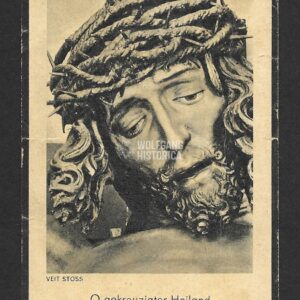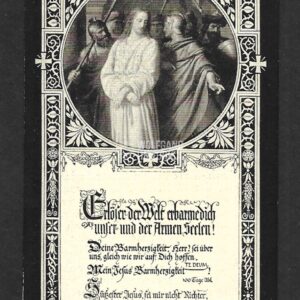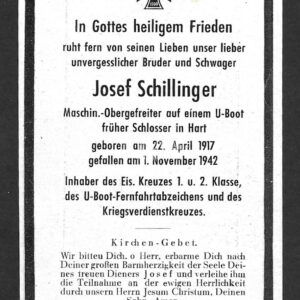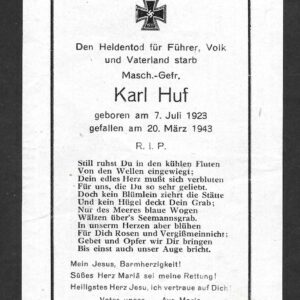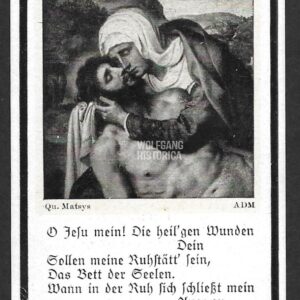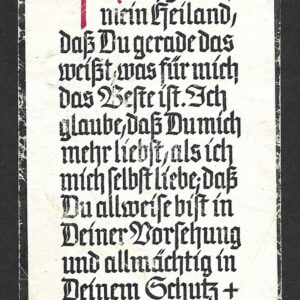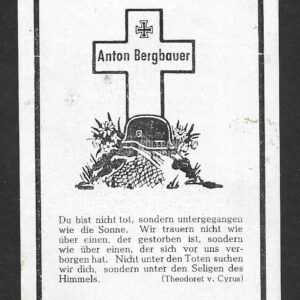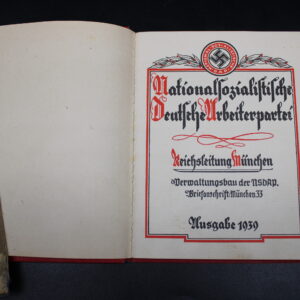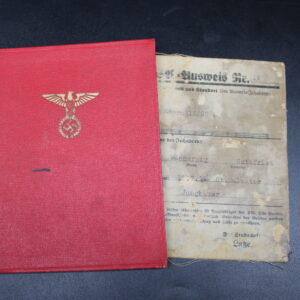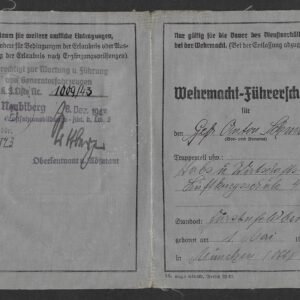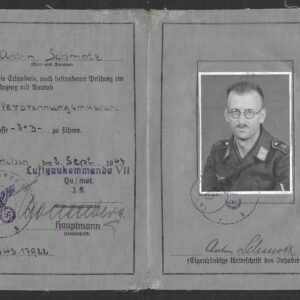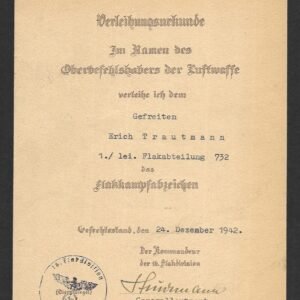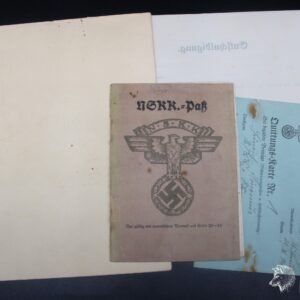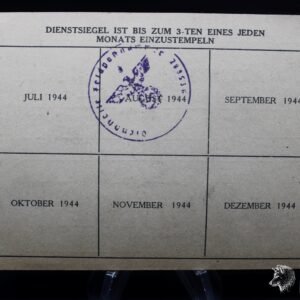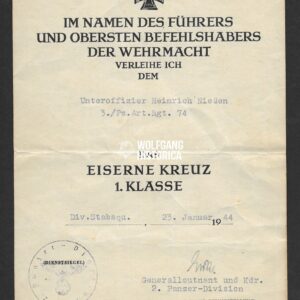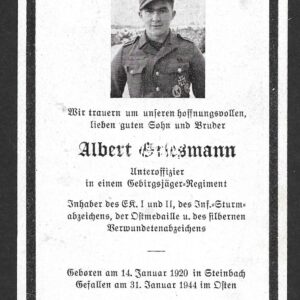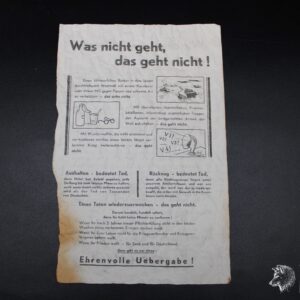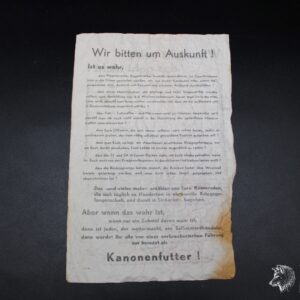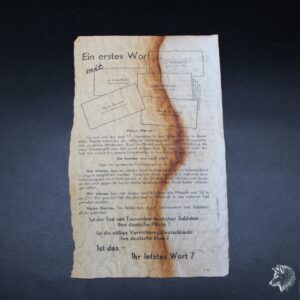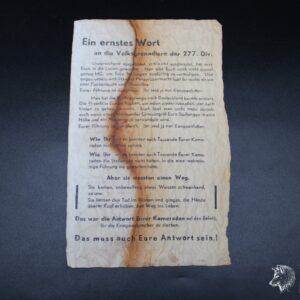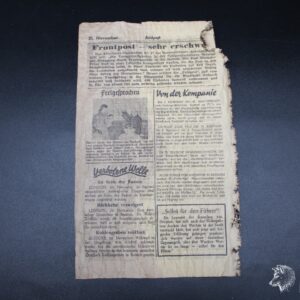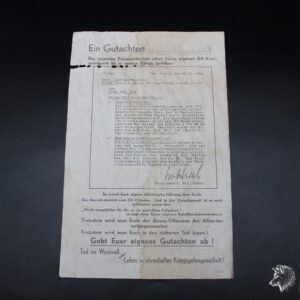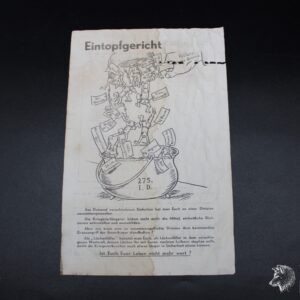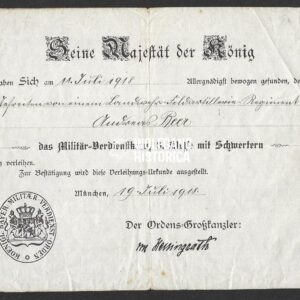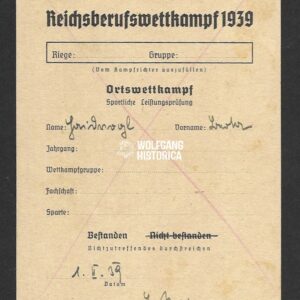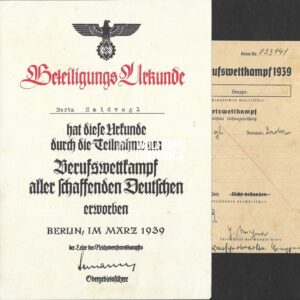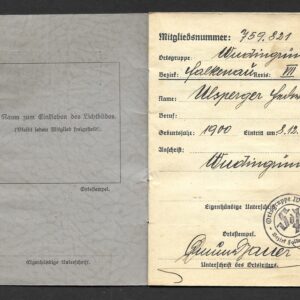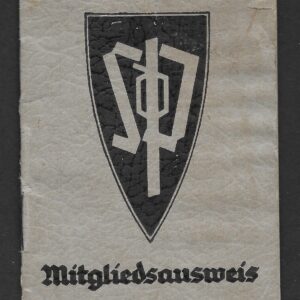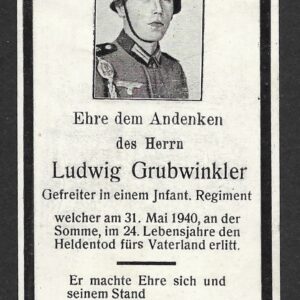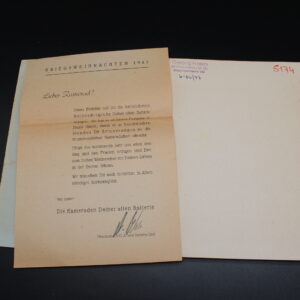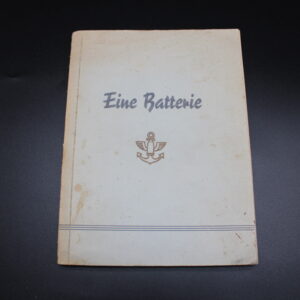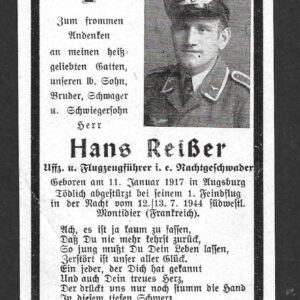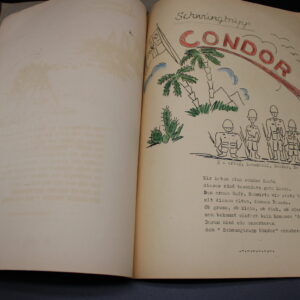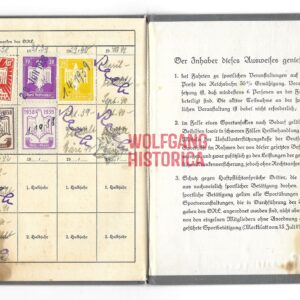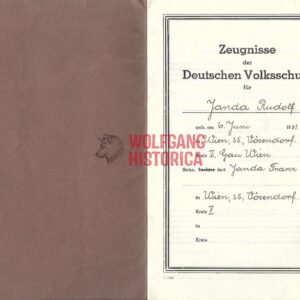Customers facing issues ordering, contact me
via info@wolfganghistorica.com or wolfganghistorica@gmail.com
NEW HOUTEN MILITARIA FAIR VIDEO ONLINE: Watch it here!
Sturmabzeichen Award Doc: Aufklärungs-Abteilung 100 (100. Jäger-Division)
€80,00An authentic wartime award document issued to Gefreiter Frescher, serving with the 1. Kompanie, Aufklärungs-Abteilung 100 of the elite 100. Jäger-Division.
-
Award: Allgemeines Sturmabzeichen (General Assault Badge)
-
Unit: 1./Aufklärungs-Abteilung 100, 100. Jäger-Division
-
Signed by: Major Gustav Grunhagen, recipient of the Deutsches Kreuz in Gold (DKiG)
-
Condition: Folded in the past, otherwise well-preserved, as seen
Historical Context
The 100. Jäger-Division was created in December 1940 from elements of the 100. leichte Infanterie-Division. Specialized in difficult terrain warfare, the division fought in Ukraine, at Stalingrad, and later in Italy. Its Aufklärungs-Abteilung 100 (Reconnaissance Battalion) played a crucial role in gathering intelligence and spearheading assaults.
The Allgemeines Sturmabzeichen was awarded to troops who participated in three or more infantry assaults, counter-attacks, or close combat actions, recognizing the frontline service of soldiers such as Gefreiter Frescher.
Collector’s Note
A fine and historically significant award document, linked to the battle-hardened 100. Jäger-Division. The signature of Major Gustav Grunhagen (DKiG) adds strong collector interest.
Sturmabzeichen Award Doc: Pionier-Kompanie 714 (714. Infanterie-Division)
€75,00An authentic wartime award document issued to Gefreiter Karcher, who served with Pionierkompanie 714 of the 714. Infanterie-Division (later re-designated as the 114. Jäger-Division).
-
Award: Allgemeines Sturmabzeichen (General Assault Badge)
-
Reason: For active participation in 3 infantry assaults
-
Signed by: Generalmajor Friedrich Stahl (Divisional Commander)
-
Condition: Document was folded in the past; overall condition as seen
Historical Context
The 714. Infanterie-Division was formed in 1941 and deployed primarily in the Balkans, where it took part in anti-partisan operations. In 1943, it was reorganized and renamed the 114. Jäger-Division, continuing service in Italy.
The Allgemeines Sturmabzeichen was instituted in 1940 and awarded to soldiers who participated in three or more infantry assaults, counter-attacks, or close combat actions, often highlighting the courage and frontline involvement of support troops such as pioneers.
Collector’s Note
A desirable and well-documented award paper, featuring the scarce divisional connection to both the Balkans campaign and the later Italian front. The signature of Generalmajor Friedrich Stahl further enhances the historical and collector’s value.
Original Double Death Card – U-boot “U-613” & Waffen-SS Brother
€75,00A very rare double death card commemorating two brothers who both lost their lives in WWII – one at sea as a U-boat sailor, the other as a Waffen-SS soldier.
Matrosengefreiter Karl Prechtl
-
Service: Crew member of U-613, a Type VIIC submarine of the Kriegsmarine.
-
Fate: On 23 July 1943, U-613 was sunk in the mid-Atlantic, south of the Azores, by depth charges from the American destroyer USS George E. Badger (DD-196). The attack occurred near Convoy UGS-12, with the destroyer operating as part of the escort group for the escort carrier USS Bogue (CVE-9).
-
Loss: All 48 crew members were killed. Wreckage and bodies were observed on the surface after the attack.
His Brother Anton Prechtl
-
Service: Member of the Waffen-SS.
-
Fate: Killed in Action on 4 October 1944 near Bozen (Bolzano), South Tyrol, during the late-war fighting in northern Italy.
Item Details:
-
Rare double Sterbebild, commemorating two brothers lost in different branches of service.
-
Represents both the U-boat war in the Atlantic and the bitter ground fighting in Italy.
-
Condition: As seen, with period wear appropriate for age.
Historical Context – U-613:
-
Commissioned in 1941 as part of the Type VIIC class, U-613 conducted patrols in the Atlantic during the height of the Battle of the Atlantic.
-
Her sinking in July 1943 reflects the increasing dominance of Allied anti-submarine tactics, with combined destroyer and escort carrier groups effectively sealing off the Atlantic.
Collector’s Note:
Double death cards are already scarce; examples combining a U-boat crewman and a Waffen-SS casualty are particularly striking. This piece highlights the fate of two brothers, one lost in the vast Atlantic with U-613, the other fallen in the mountains of northern Italy in 1944. A powerful family memorial with strong historical and emotional significance.
Deathcard of U-Boot Crewmember – U-Boot “U-578” (Unexplained Disappearance))
€55,00Original WWII death card (Sterbebild) for Matrosenobergefreiter Josef Seidl, who served aboard the German submarine U-578.
Service & Fate:
Josef Seidl was a crew member of U-578, a Type VIIC U-boat of the Kriegsmarine. On 6 August 1942, U-578 departed St. Nazaire for operations in the Bay of Biscay and was never heard from again. The submarine was officially declared lost with 49 dead (all hands).
Earlier accounts incorrectly credited her sinking to a Vickers Wellington H of RAF 311 (Czechoslovak) Squadron on 10 August 1942, but modern research has disproven this claim. The true cause of U-578’s disappearance remains unknown.
Item Details:
-
Original wartime Sterbebild of Josef Seidl.
-
Memorial for a sailor lost in one of the war’s unexplained U-boat disappearances.
-
Condition: As seen, with expected age-related wear.
Historical Context – U-578:
-
Type: Type VIIC submarine, backbone of the German U-boat fleet.
-
Patrols: Took part in Atlantic convoy hunting operations during the height of the Battle of the Atlantic.
-
Loss: Her disappearance highlights the dangers of minefields, technical failures, or unrecorded Allied attacks, which remain part of the mystery surrounding U-boat warfare.
Collector’s Note:
Death cards from mysteriously lost U-boats like U-578 are highly sought after. This example, dedicated to Josef Seidl, connects directly to one of the Kriegsmarine’s unsolved wartime losses. A poignant and historically significant addition to any collection of U-boat and naval memorabilia.
Deathcard of U-Boot Crewmember – U-Boot “U-254” (Sunk due Collission with U-221!)
€55,00Original WWII death card (Sterbebild) honoring Heinrich Jerzenbeck, a crew member of the German submarine U-254.
Service & Fate:
Jerzenbeck served aboard U-254, a Type VIIC U-boat of the Kriegsmarine. On 8 December 1942, while operating in the North Atlantic south-east of Cape Farewell, Greenland, U-254 collided with U-221 at position 58.45N, 33.02W. The submarine was lost with 41 men killed, while only 4 survived.
Item Details:
-
Original WWII Sterbebild memorial card.
-
Commemorates a fallen U-boat crewman from the Atlantic campaign.
-
Condition: As seen, with age wear consistent with period authenticity.
Historical Context – U-254:
-
Type: VIIC U-boat, the standard class of Germany’s U-Bootwaffe.
-
Patrols: Prior to its loss, U-254 had operated against Allied shipping during the critical mid-war period.
-
Fate: The loss highlights the extreme dangers of U-boat service—not only from enemy action but also from accidents at sea.
-
Casualties: 41 dead, 4 survivors, making this one of the rare instances of U-boat losses caused by a collision with another German submarine.
Collector’s Note:
A poignant and scarce Kriegsmarine death card, tied to the tragic story of U-254. Items related to submarines lost through non-combat accidents are particularly notable, offering a unique perspective on the dangers faced by U-boat crews. A meaningful addition to any U-boat or Kriegsmarine collection.
Deathcard of U-Boot Crewmember – U-Boot “U-332” (Sunk by British Liberator)
€55,00Service & Fate:
Schneider served aboard U-332, a Type VIIC U-boat of the Kriegsmarine. On 29 April 1943, U-332 was sunk in the Bay of Biscay north of Cape Finisterre, Spain, at position 45.08N, 09.33W. The submarine was destroyed by depth charges from a British Liberator aircraft of No. 224 Squadron RAF (D). All 45 men on board were lost, with no survivors.
Item Details:
-
Original WWII Sterbebild memorial card.
-
Honors a fallen U-boat crewman from the Battle of the Atlantic.
-
Condition: As seen, with period age wear.
Historical Context – U-332:
-
Type: Type VIIC U-boat, the backbone of Germany’s submarine fleet.
-
Patrols: Before her loss, U-332 completed several war patrols and successfully attacked Allied shipping.
-
Loss: By spring 1943, Allied anti-submarine measures, including long-range patrol aircraft like the Liberator, were turning the tide of the Atlantic war. U-332’s destruction was part of this intensified campaign.
-
Crew: 45 dead (all hands lost) highlights the extreme risks and fatal outcomes common among U-boat crews.
Collector’s Note:
This memorial card for Josef Schneider of U-332 represents not only the sacrifice of one man but also the fate of an entire U-boat crew during the turning point of the Battle of the Atlantic. A poignant and historically significant addition for any Kriegsmarine or U-boat collection.
Deathcard of U-Boot Crewmember – U-Boot “U-222” (Collided with “U-626”)
€55,00Original WWII death card (Sterbebild) commemorating Richard Donhauser, a crew member of the German submarine U-222.
Service & Fate:
Donhauser served aboard U-222, a Type VIIC U-boat of the Kriegsmarine. On 2 September 1942, during training operations in the Baltic Sea west of Pillau, U-222 collided with U-626 and sank at position 54.25N, 19.30E. Of the crew, 42 men perished and only 3 survived.
Item Details:
-
Original wartime Sterbebild memorial card.
-
Honors a submariner lost in a rare training accident rather than combat.
-
Condition: Good, with light age wear.
Historical Context – U-222:
-
Type: Type VIIC U-boat, backbone of the German U-boat fleet.
-
Role: Training and preparation for operational deployment.
-
Loss: Unlike many U-boats sunk in the North Atlantic by Allied forces, U-222’s loss came through a collision during exercises, highlighting the inherent dangers of submarine service even far from enemy action.
Collector’s Note:
This death card for Richard Donhauser represents the sacrifices of U-boat crews not only in combat but also in training. With only 3 survivors out of 45 men, the loss of U-222 stands as a stark reminder of the constant risks faced by the Kriegsmarine’s submarine arm. A poignant and historically significant piece for collectors of U-boat and Kriegsmarine memorabilia.
Deathcard of U-Boot Crewmember (Narvikschild!) – U-Boot “U-567” (Sunk by British Sloop HMS Deptford)
€55,00Service & Fate:
Lehr served aboard U-567, a Type VIIC U-boat of the Kriegsmarine. On 21 December 1941, the submarine was sunk in the North Atlantic north-east of the Azores, at position 44.02N, 20.10W, after being attacked with depth charges from the British sloop HMS Deptford. The boat was lost with all 47 crew members.
Item Details:
-
Original wartime Sterbebild memorial card.
-
Commemorates a sailor lost at sea with his boat during the height of the Battle of the Atlantic.
-
Condition: As seen, with light age wear consistent with period pieces.
Historical Context – U-567:
-
Type: Type VIIC U-boat, the workhorse of the German submarine fleet.
-
Role: Assigned to the 1st U-boat Flotilla, U-567 operated in the North Atlantic.
-
Commander: At the time of her loss, U-567 was under Kapitänleutnant Engelbert Endrass, a Knight’s Cross with Oak Leaves holder and one of Germany’s notable U-boat aces.
-
Loss: The sinking marked the end of Endrass’s career and deprived the Kriegsmarine of one of its most promising young commanders.
Collector’s Note:
This death card is not only a memorial to Otto Lehr but also directly connected to Kapitänleutnant Endrass, one of the most famous U-boat commanders. With all 47 hands lost, U-567’s sinking reflects the extreme risks of submarine warfare. An evocative and historically significant piece for collectors of Kriegsmarine and U-boat memorabilia.
Deathcard of U-Boot Crewmember – U-Boot “U-520” (Sunk by Canadian Digby aircraft)
€55,00Service & Fate:
Schillinger served aboard U-520, a Type IXC U-boat of the Kriegsmarine. On 30 October 1942, the submarine was sunk in the North Atlantic east of Newfoundland, at position 47.47N, 49.50W, by depth charges from a Canadian Digby aircraft (No. 10 Squadron RCAF/Z). The entire crew of 53 men perished — all hands lost.
Item Details:
-
Original wartime Sterbebild memorial card.
-
Commemorates a sailor lost with his boat during the Battle of the Atlantic.
-
Condition: As seen, with period patina and age wear.
Historical Context – U-520:
-
Type: Type IXC U-boat, designed for long-range patrols in distant waters.
-
Patrols: Operated in the Atlantic during 1942, a period of high U-boat activity against Allied shipping.
-
Loss: The sinking by Canadian forces highlights the growing effectiveness of Allied anti-submarine warfare in the Northwest Atlantic by late 1942.
-
Casualties: All 53 crew members lost, making this Sterbebild a poignant remembrance of the human cost of submarine warfare.
Collector’s Note:
Death cards from U-boat crew members are especially collectible when connected to boats that suffered the fate of total loss at sea. This Sterbebild for Josef Schillinger of U-520 preserves the personal memory of one of the 53 sailors who perished, making it a rare and historically significant piece for collectors of Kriegsmarine and Battle of the Atlantic memorabilia.
Deathcard of U-Boot Crewmember – U-Boot “U-226” (Sunk East of Newfoundland, UK)
€50,00Service & Fate:
Grundl served aboard U-226, a Type VIIC U-boat of the Kriegsmarine. On 6 November 1943, the submarine was sunk in the North Atlantic east of Newfoundland, at position 44.49N, 41.13W, by depth charges from the British sloops HMS Starling, HMS Woodcock, and HMS Kite. The entire crew of 51 men perished — all hands lost.
Item Details:
-
Original wartime Sterbebild memorial card.
-
Dedicated to a fallen U-boat sailor.
-
Condition: As seen, with period patina and light age wear.
Historical Context – U-226:
-
Type: Type VIIC U-boat, the most common German submarine class of WWII.
-
Operations: Conducted Atlantic patrols during the height of the Battle of the Atlantic.
-
Loss: Destroyed in November 1943 during heavy Allied anti-submarine operations by escort groups.
-
Significance: U-226’s destruction underlines the increasing effectiveness of Allied convoy escorts and hunter-killer groups from 1943 onward.
Collector’s Note:
Death cards from U-boat crewmen are highly collectible, especially when tied to boats where all hands were lost. This example for Sepp Grundl of U-226 offers a personal and poignant remembrance of the immense risks faced by U-boat sailors during the later, deadly phase of the Battle of the Atlantic.
Deathcard of U-Boot Crewmember – U-Boot “U-375” (Sunk by British Destroyers)
€55,00Service & Fate:
Rudolf Braun served aboard U-74, a Type VIIB U-boat of the Kriegsmarine. On 2 May 1942, the submarine was sunk in the Mediterranean east-southeast of Cartagena, Spain, at position 37.12N, 00.01E, by depth charges from the British destroyers HMS Wishart and HMS Wrestler. The entire crew of 47 men perished — no survivors.
Item Details:
-
Original wartime Sterbebild memorial card.
-
Commemorates the ultimate sacrifice of a U-boat crewman.
-
Condition: As seen, with period patina and age-related wear.
Historical Context – U-74:
-
Type: Type VIIB U-boat, an early but effective design.
-
Operations: Served in the Atlantic and later the Mediterranean, supporting Axis naval operations.
-
Loss: Destroyed in May 1942 during the intensified Allied anti-submarine campaign in the Mediterranean.
-
Significance: U-74’s sinking highlighted the increasing dangers U-boats faced in contested waters, particularly from coordinated destroyer patrols.
Collector’s Note:
Death cards from U-boat crews represent both personal remembrance and a stark reminder of the heavy toll of the Battle of the Atlantic and Mediterranean. With all hands lost, this piece offers a direct and human connection to the men who served — and died — in the Kriegsmarine’s submarine arm.
Deathcard of U-Boot Crewmember – U-Boot “U-384” (Sunk by British Fortress!)
€55,00Service & Fate:
Karl Huf served aboard U-384, a Type VIIC U-boat of the Kriegsmarine. On 19 March 1943, at 1745 hrs, the submarine was sunk in the North Atlantic west of Ireland, at position 54.18N, 26.15W. The sinking was caused by depth charges dropped by a British Fortress aircraft (206 Sqn RAF/B). All 47 crew members were lost — no survivors.
Item Details:
-
Original wartime Sterbebild commemorating Karl Huf.
-
A poignant relic tied to the Battle of the Atlantic.
-
Condition: As seen, with natural age-related wear.
Historical Context – U-384:
-
Type: Type VIIC, the workhorse of the German U-Bootwaffe.
-
Patrols: Conducted only two patrols.
-
Loss: Destroyed during the height of the 1943 “air gap” battles, when Allied aircraft extended their coverage deep into the Atlantic.
-
Legacy: The destruction of U-384 illustrates the increasing vulnerability of German U-boats during the critical turning point of the Battle of the Atlantic.
Collector’s Note:
This death card serves as both a personal memorial and a tangible link to the brutal campaign waged beneath the Atlantic waves. Pieces connected to U-boat crews lost with all hands are particularly valued, reflecting the tragic sacrifices of the U-Bootwaffe.
Deathcard of U-Boot Crewmember – U-Boot “U-194” (Sunk by US Catalina Aircraft)
€55,00Service & Fate:
Heinrich Lutz served aboard U-194, a Type IXC/40 long-range U-boat of the Kriegsmarine. On 24 June 1943, during its maiden patrol, U-194 was sunk in the North Atlantic south-west of Iceland at position 59.00N, 26.18W. The submarine was destroyed by a newly introduced Fido homing torpedo launched from a U.S. Navy Catalina aircraft (VP-84 USN/G). All 54 crew members perished — there were no survivors.
Item Details:
-
Original wartime Sterbebild (death card) of Heinrich Lutz.
-
A solemn memorial from one of the U-boat arm’s darkest periods.
-
Condition: As seen, with expected age wear.
Historical Context – U-194:
-
Type: Type IXC/40, a larger and longer-ranged variant of the Type IX U-boat.
-
Commissioned: 1942 under Korvettenkapitän Hermann Hess.
-
Patrols: Only one, beginning in June 1943.
-
Significance: U-194 was among the first U-boats destroyed by the revolutionary Fido (Mk 24 “Mine”) acoustic homing torpedo, marking a turning point in Allied anti-submarine warfare.
-
Legacy: Its loss exemplified the increasing danger faced by U-boat crews in 1943, the “black year” of the U-boat arm.
Collector’s Note:
This death card represents not just a single fallen sailor, but also a key moment in U-boat history — the devastating effectiveness of Allied technological advances against the once-feared “grey wolves” of the Atlantic. With U-194 lost on her very first patrol, such pieces are scarce and highly desirable for collectors of Kriegsmarine and U-Bootwaffe history.
Deathcard of U-Boot Crewmember – U-Boot “U-215” (Sunk East of Boston, US!)
€55,00Service & Fate:
Ferdinand Popijal served aboard U-215, a Type VIID minelaying U-boat of the Kriegsmarine. On 3 July 1942, during its first patrol, U-215 was sunk in the North Atlantic east of Boston at position 41.48N, 66.38W. The submarine was destroyed by depth charges from the British anti-submarine trawler HMS Le Tiger, while attempting to lay mines off Halifax. All 48 crew members perished — no survivors.
Item Details:
-
Original wartime Sterbebild (death card) for Ferdinand Popijal.
-
A poignant memorial to a fallen sailor of U-215.
-
Condition: As seen, with age-related wear.
Historical Context – U-215:
-
Type: Type VIID minelaying U-boat, one of only six built.
-
Commissioned: 1941 under Kapitänleutnant Fritz Hoevelmann.
-
Patrols: Only one war patrol.
-
Final Mission: Attempted to lay mines in Canadian waters; sunk before completing its operation.
-
Legacy: Its wreck was located in 2004 off Nova Scotia, designated a war grave.
Collector’s Note:
Death cards from the rare Type VIID minelaying U-boats are scarce, as these submarines were few in number and most were lost with all hands. The card of Ferdinand Popijal thus offers not only a personal link to the fallen crew but also to a very rare class of U-boat, making it a highly desirable piece for collectors of Kriegsmarine and Battle of the Atlantic memorabilia.
Deathcard of U-Boot Crewmember – U-Boot “U-460” (Sunk by US Avenger & Wildcraft Aircraft)
€55,00Service & Fate:
Hans Hobelsberger served aboard U-460, a Type XIV “Milchkuh” supply submarine of the Kriegsmarine. On 4 October 1943, while operating in the North Atlantic north of the Azores, the U-boat was attacked by aircraft from the American escort carrier USS Card (CVE-11). Depth charges dropped by Avenger and Wildcat aircraft of VC-9 Squadron sank the submarine at position 43.18N, 28.58W. Out of the crew, 62 men perished and only 2 survived.
Item Details:
-
Original wartime Sterbebild (death card) commemorating Hans Hobelsberger.
-
A solemn remembrance of his service aboard U-460.
-
Condition: As seen, with period patina and wear.
Historical Context – U-460:
-
Type: Type XIV supply submarine (“Milchkuh”).
-
Commissioned: 1941 under Korvettenkapitän Friedrich Schäfer.
-
Role: Served as a critical mid-Atlantic tanker and supply boat, refueling combat U-boats far from base.
-
Loss: Destroyed in October 1943 during intensified Allied anti-submarine operations — part of the turning tide in the Battle of the Atlantic.
Collector’s Note:
Death cards related to supply U-boats (Milchkühe) are exceptionally rare, as these submarines were few in number and most were lost in 1943–44. The card of Hans Hobelsberger represents not only the human cost of submarine warfare but also the vital role of the “Milchkühe” in sustaining U-boat operations across the Atlantic. A scarce and highly desirable item for collectors of U-boat history and Battle of the Atlantic memorabilia.
Deathcard of U-Boot Crewmember – U-Boot “U-189” (Sunk by British Liberator)
€55,00Original WWII death card (Sterbebild) for Xaver Ehrensperger, a crew member of German submarine U-189.
Service & Fate:
Xaver Ehrensperger served aboard U-189, a Type IXC/40 U-boat of the Kriegsmarine. On 23 April 1943, U-189 was sunk in the North Atlantic east of Cape Farewell, Greenland, at position 59.50N, 34.43W. The submarine was destroyed by depth charges dropped from a British Consolidated B-24 Liberator of No. 120 Squadron RAF (pilot: F/O D.E. Curtis).
The sinking resulted in the loss of all 54 crew members, including Ehrensperger — no survivors.
Item Details:
-
Original wartime Sterbebild (death card) of Xaver Ehrensperger.
-
Commemorates his sacrifice while serving on U-189.
-
Condition: As seen; light handling wear consistent with age.
Historical Context – U-189:
-
Type: Type IXC/40 ocean-going U-boat.
-
Commissioned: 1942 under Kapitänleutnant Hellmut Kallmann.
-
Operations: Operated in the North Atlantic against Allied convoys.
-
Loss: Destroyed on her first patrol in April 1943, with the total loss of crew.
Collector’s Note:
Death cards linked to U-boat crews lost with all hands are highly sought after, as they represent both personal remembrance and the broader tragedy of the Battle of the Atlantic. This example for Xaver Ehrensperger of U-189 is a poignant reminder of the extreme dangers faced by German submariners, who suffered some of the highest casualty rates of any service in WWII.
Deathcard of U-Boot Crewmember – U-Boot “U-578” (MIA August 1942, No Explanation)
€55,00Service & Fate:
Martin Braun served aboard U-578, a Type VIIC U-boat of the Kriegsmarine. On 6 August 1942, the submarine was reported missing in the Bay of Biscay. No explanation for her loss has ever been determined. The disappearance resulted in the loss of all 49 crew members, including Braun — no survivors.
Item Details:
-
Original wartime Sterbebild (death card) of U-boat crew member Martin Braun.
-
Commemorates his sacrifice while serving aboard U-578.
-
Condition: As seen; shows age and wear consistent with period.
Historical Context – U-578:
-
Type: Type VIIC Atlantic-class submarine.
-
Commissioned: 1941 under Kapitänleutnant Ernst-August Rehwinkel.
-
Operational History: Took part in Atlantic convoy battles, credited with sinking several Allied vessels.
-
Loss: Disappeared without trace in August 1942 in the Bay of Biscay; circumstances remain unknown.
Collector’s Note:
Death cards linked to U-boats lost with all hands are highly sought after, as they reflect both personal remembrance and the perilous nature of the Battle of the Atlantic, where over 70% of U-boat crews never returned. This example for Martin Braun of U-578 offers a poignant and rare memorial connection to one of the Kriegsmarine’s many missing submarines.
Deathcard of U-Boot Crewmember – U-Boot “U-609” (Sunk by a Free French corvette)
€30,00Service & Fate:
Engelbrecht served aboard U-609, a Type VIIC U-boat of the Kriegsmarine. On 6 February 1943, at 2204 hours, U-609 was sunk in the North Atlantic south-east of Cape Farwell, Greenland, at position 54.56N, 28.11W. The submarine was destroyed by depth charges from the Free French corvette Lobelia. All 47 crew members perished, with no survivors.
Item Details:
-
Original WWII Sterbebild memorial card.
-
Commemorates a submariner lost with his entire crew during the height of the Battle of the Atlantic.
-
Condition: As seen, with natural signs of age.
Historical Context – U-609:
-
Type: Type VIIC U-boat, the most numerous and iconic U-boat class.
-
Loss: The destruction of U-609 is notable as part of the Allied anti-submarine campaign, where even Free French naval forces played a decisive role in closing the Atlantic shipping lanes to German raiders.
-
Crew: 47 men lost, a stark reminder of the heavy toll faced by U-boat crews.
Collector’s Note:
This death card of Willibald Engelbrecht is a tangible piece of Kriegsmarine and U-boat history, tied directly to the dramatic naval struggle of the North Atlantic. Losses to Free French forces are comparatively rare, making this a particularly interesting addition for collectors of submarine and naval memorabilia.
Deathcard of U-Boot Crewmember – U-Boot “U-460” (Sunk by US Avenger & Wildcraft Aircraft)
€30,00Service & Fate:
Bergbauer served aboard U-460, a Type XIV “Milchkuh” supply submarine of the Kriegsmarine. On 4 October 1943, the boat was sunk in the North Atlantic north of the Azores, at position 43.18N, 28.58W, by depth charges from Avenger and Wildcat aircraft (VC-9) of the American escort carrier USS Card. Of the crew, 62 men were killed and only 2 survived.
Item Details:
-
Original wartime Sterbebild memorial card.
-
Commemorates a sailor lost with his boat in one of the rare supply U-boat sinkings.
-
Condition: As seen, with natural age wear and patina.
Historical Context – U-460:
-
Type: Type XIV U-boat (nicknamed Milchkuh or “Milk Cow”), designed to resupply other U-boats at sea.
-
Role: These boats carried fuel, torpedoes, food, and provisions, greatly extending the range of attack submarines during the Battle of the Atlantic.
-
Loss: The sinking of U-460 was part of the concerted Allied effort to hunt down and destroy Milchkuh U-boats, severely weakening German U-boat endurance in the Atlantic.
-
Casualties: The destruction of U-460 with 62 dead illustrates the high risks faced by even non-combatant support submarines.
Collector’s Note:
Sterbebilder from supply U-boats are especially scarce due to the limited number of these vessels built and their strategic importance. This death card for Anton Bergbauer offers a rare memorial to one of the sailors lost in the sinking of U-460, making it a significant and poignant addition for collectors of Kriegsmarine and Battle of the Atlantic relics.
Panzer Assault Badge in Bronze Award Doc: Panzergrenadier-Regiment 108
€135,00Enveloppe of the Reichskommissar Niederlande (Seyss-Inquart)
€95,00NSDAP Parteibuch & SA-Ausweis (St. Salvator)
€250,00Punishing Paper Kriegskommandantur Ypern (Ieper)
€25,00RKT Award Document Grouping – Adolf Fischbach, Kampfgeschwader 27 “Boelcke”
€3.500,00Original interesting and rare award document grouping for Adolf Fischbach, who served with the Kampfgeschwader 27 “Boelcke” and earned the Knight's Cross of the Iron Crosses! The set includes a total of nine award certificates, a Knight’s Cross telegram, a letter detailing his actions, and a Pokal (honor goblet) recipient list.
The documents cover awards such as all three bomber clasps (including one with hanger), the Eastern Front Medal (Ostmedaille), Iron Cross 2nd Class, Iron Cross 1st Class, Pilot Badge, and the Honor Goblet certificate.
Please note: The presentation documents for the Knight’s Cross (Verleihungsurkunde) and the German Cross in Gold are not included.
All items remain in good condition overall. The A5-sized documents have standard filing holes on the sides, and the Pilot Badge and Goblet documents show light signs of age.
Fischbach flew 446 combat sorties and was awarded the Honor Goblet for successfully destroying a train consisting of 40–50 wagons. A rare and desirable grouping with the majority of key documents present.
WH Führerschein – Luftkriegsschule 4
€55,00Faithful Service Medal 25 Years Award Doc – Woman in Bochum
€40,00Dienstauszeichnung für den Reichsarbeitsdienst 4. Stufe Award Doc
€80,00Fragebogen für Ausländer – Belgian from Kerkrade
€110,00Award Doc for Flakkampfabzeichen (Flak-Abteilung 732)
€125,00NSKK-Paß Sturm 26/M141 Meuselwitz/Thüringen, Motorgruppe Leipzig
€90,00Ausweis Ortskommandantur 1/643 – Alarm-Rgt. Brussel
€75,00Feldpostbrief des SS-Oberabschnitss Alpenland (Brief 4, Juni 1942)
€125,00EK1 Award Doc: Panzer-Artillerie-Rgt. 74 (2. Panzer-Division) – Hummel Battery!
€150,00VWA Schwarz Award Doc: Schützen-Rgt. 304 (2. Panzer-Division) – Signed by Mickley!
€55,00Death Card: Gebirgsjäger-Regiment (Top Photo)
€10,00US Airborne Propaganda Leaflet (Wir bitten um Auskunft)
€25,00US Airborne Propaganda Leaflet (277.Volksgrenadier-Division)
€25,00US Airborne Propaganda Leaflet (Feldpost 21.Nov.1944)
€25,00US Airborne Propaganda Leaflet (275.Infanterie-Division)
€25,00Faithful Service Medal “25 Years” Award Document – Zollsekretär in Berlin-Tempelhof
€40,00WW1 Award Doc: Militär-Verdienstkreuz 3. Klasse mit Schwertern
€45,00WW1 Award Doc: König Ludwig-Kreuz – August 1918
€30,00BDM Participation Certificate – Reichsberufswettkampf 1939
€45,00KVK2X Award Doc – 454. Sicherungs-Division & Hunde-Staffel (Dog Squad!)
€100,00KVK2X Award Doc – Signed by Georg Lindemann (RK+EL)
€65,00In stock











